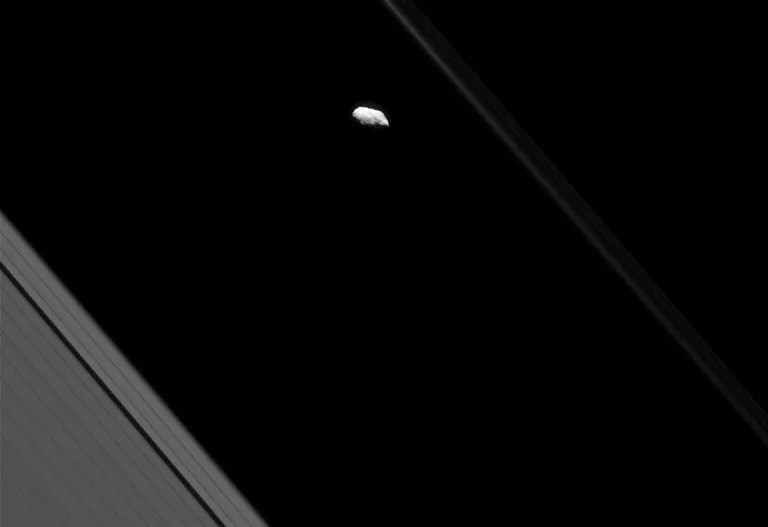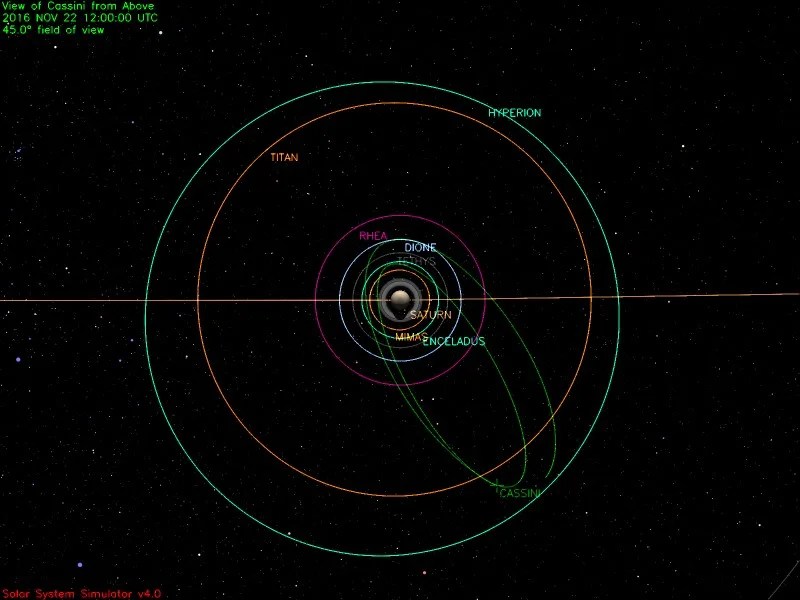4 min read

Cassini finished executing all the commands in its S96 sequence this week, examining Saturn, its rings, and three of its moons. The S97 commands were uplinked this week. Within that sequence will be the beginning of the "High-Flying, Ring Grazing Orbits" starting on Nov. 30, that are the subject of a short video available here: /news/12970/nasa-saturn-mission-prepares-for-ring-grazing-orbits .
The additional 10-week sequences S98, S99 and S100 are now in various stages of work back here on Earth. These will control Cassini through early next July. Then the final set of commands in S101 will control the spacecraft and its instruments through the end of this unique planetary mission, on Sept. 15, 2007.
Wednesday, Nov. 16 (DOY 321)
Cassini's Composite Infrared Spectrometer (CIRS) began the week by staring at Saturn's northern hemisphere for 13.5 hours, covering a little more than one complete rotation of the gas-giant planet. The data will help scientists study the atmosphere's composition. The Visible and Infrared Mapping Spectrometer (VIMS) and the Ultraviolet Imaging Spectrograph (UVIS) rode along.
Cassini turned and fired its small rocket thrusters for 151 seconds today in response to realtime commands to execute Orbit Trim Maneuver (OTM)-464. The burn provided the spacecraft a change in velocity of 142 millimeters per second, cleaning up the trajectory following last week's Titan encounter T-124.
Thursday, Nov. 17 (DOY 322)
VIMS and UVIS took turns making observations for 12.5 hours today, one leading, one riding. The Imaging Science Subsystem (ISS) also rode along for each. The activities examined Saturn's northern hemisphere, including the auroras there.
Friday, Nov. 18 (DOY 323)
VIMS spent another 9.3 hours observing Saturn’s north polar region, while ISS, CIRS, and UVIS rode along. VIMS and CIRS then spent 2.5 hours observing the occultation of the reddish star Gamma Crucis while it approached and then set into Saturn’s atmosphere.
The flight team uplinked the S97 command sequence to Cassini today, using the 70-meter diameter Deep Space Network (DSN) station in Australia. The nearly 10 thousand individually timed commands in this load will control Cassini's activities for 10 weeks. All the commands were confirmed to have been received and stored aboard, and they will begin executing early on Wednesday.
Saturday, Nov. 19 (DOY 324)
CIRS, VIMS, ISS, and UVIS observed Saturn's small icy moon Mimas for three hours, just as Cassini reached periapsis in its orbit #248 of Saturn. CIRS then observed Saturn's bright limb for six hours, with ISS, VIMS and UVIS riding along. VIMS and CIRS then began a nine-hour observation of Saturn’s southern-storm latitudes.
Sunday, Nov. 20 (DOY 325)
VIMS and CIRS watched Saturn’s equatorial latitudes during a 2.5-hour observation. Cassini then turned towards Titan so that ISS, CIRS, and VIMS could perform a 90-minute monitoring observation while the planet-like moon was 1.4 million kilometers away. Finally today, VIMS and UVIS jointly observed a solar occultation of Saturn's rings for 6.5 hours to study the size and spatial distributions of the smallest particles in the rings.
Monday, Nov. 21 (DOY 326)
VIMS and CIRS mapped Saturn’s southern hemisphere for just under five hours. CIRS then stared at Saturn’s southern hemisphere to study atmospheric composition for 11 hours while the giant planet rotated once. VIMS and UVIS rode along. UVIS then led an observation with all other optical instruments riding along, to look for volatiles as part of an icy-satellite exospheres campaign as Saturn's big icy moon Rhea occulted the bright blue star Zeta Orionis. ISS then imaged along the bright limb of Saturn, with VIMS and UVIS riding, for a little over two hours.
An image featured today visits Saturn's little moon Prometheus, which makes regular intrusions into the narrow F ring as it orbits the massive gas giant once every 14.6 hours: /resources/17554 .
Tuesday, Nov. 22 (DOY 327)
UVIS mapped Saturn at ultraviolet wavelengths to study the distribution of hazes and organic compounds high in the planet's atmosphere. CIRS and ISS rode along with the 13.4-hour observation. This was the final science activity in the S96 command sequence.
The Deep Space Network communicated with and tracked Cassini six times this week, using stations in Australia and California. A total of 14,030 individual commands were uplinked, and about 1,840 megabytes of telemetry data were downlinked and captured at rates as high as 110,601 bits per second.
Wrap up:
Cassini is orbiting Saturn with a period of eight days in a plane inclined 61.4 degrees from the planet's equatorial plane. The most recent spacecraft tracking and telemetry data were obtained on Nov. 22, using the 70-meter diameter DSN station in Australia. The spacecraft continues to be in an excellent state of health with all of its subsystems operating normally except for the instrument issues described athttp://saturn.jpl.nasa.gov/anomalies .
Cassini's path up to mid-day Nov. 22 is illustrated here:http://go.nasa.gov/2ef9McI . At that time, the countdown clock in Mission Control was showing 296 days until the end of the mission.
An illustration of Cassini's path up to mid-day Nov. 22, 2016.








